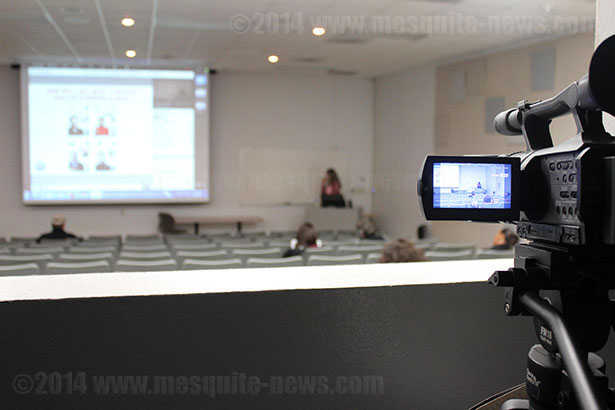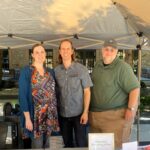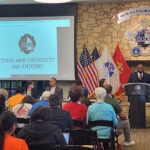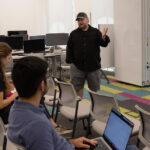
By Rebecca Salinas
The College of Business will expand the number of HyFlex courses from 15 to 25 sections to serve an estimated 750-800 students in the fall.
The HyFlex, or Hybrid Flexible, model was developed so students can attend class either on campus or online asynchronously. Dr. Tracy Hurley, dean of the college of business, piloted the program with six classes last fall.
A single recording system records classes in the Brooks City-Base Campus’ small auditorium. Installation of a second system in a classroom has been requested.
Dr. Syed Harun, chair of the school of business, said the whole idea of a HyFlex course is that a student chooses how he or she wants to attend class.
“We have been trying to figure a way out to improve student learning to other means instead of forcing them to attend,” he said.
The College of Business is currently the only department that uses the HyFlex model. Classes run from morning to evening. In the fall semester only evening classes were recorded.
The HyFlex model was introduced in 2006 by Dr. Brian Beatty, associate vice president of academic affairs operations at San Francisco State University, according to his website.
According to “Blended Learning for Students with Choice,” a PowerPoint by Beatty, HyFlex courses were designed to give students, who are already busy with families and jobs, more control of their lives. If students are able to attend class wherever they please, they can adapt school life to their responsibilities.
Beatty was unavailable for an interview by publication deadline.
Convenient learning methods
Professors also incorporate technology in the class by pre-recording lectures.
Sherita Love, manager of academic technologies, said a lot of faculty members pre-record their lectures and upload them to YouTube so students can study them at their convenience.
A HyFlex course is an extension of a hybrid course and an “…initiative to adopt online learning,” said Ruben Rodriguez, instructional technologist and academic systems administrator.
The university uses a platform called Adobe Connect and each instructor has their virtual classroom set up through the platform. Students can access the virtual classroom through a link located in Blackboard. Clicking on the link will direct students to the live classroom meeting.
Rodriguez said when signed on to Adobe Connect, professors can start their webcam and microphone, and are instantly streamed live. Students can see exactly what is happening in the class and even chat with the professor, if the professor accepts a chat request.
Professors also have the capability to share their screen, so students know exactly what the professor can see on their computer.
Rodriguez said professors have a computer called Hitachi Starboard installed with a software called Starboard. The software allows professors to write on the screen, like they would on a whiteboard or chalkboard, with a special pen. If professors use Starboard to take notes, those notes can be linked to students through a share option.
After class, professors can post the link to the recording on Blackboard so students will be able to visit the meeting if they did not attend class or want to watch it again. Students can pause, fast-forward or rewind a recording to find a specific moment in the class.
Harun said the HyFlex courses last fall were core business classes, divided into more sections and a higher enrollment. He said because not all students were able to make it to the scheduled class times, there were scheduling problems.
He said the department is trying to find efficient ways to help nontraditional students.
Hurley said the business department is different from other departments because it offers more evening classes to students.
She said the department is limited in classrooms, so they do not have as many classes at night as they would like to have.
But with the program, a class can be set during the day and students can attend online whenever they please.
“It allows us to try and accommodate (the students) by offering more classes,” she said.
Other than a shortage of classrooms, Hurley said students have been requesting more online classes to suit their schedule.
Love said, “This program was designed to accommodate working students. It is designed to provide options.”
Last semester, 100 students participated in a survey for HyFlex courses, which received positive reviews. Students liked the flexibility and convenience of the classes, which Love said is one reason they registered for the class in the first place.
When the program first started, Love said there was a low attendance online. After the students became aware of the technology, more started to use the software.
One problem professors are seeing is faculty members do not always see their students face-to-face, making it harder to communicate with them if they see a student struggling.
Harun said professors are looking for a better way to communicate with students who only attend online. He said a lot of students have responsibilities with their families or jobs, so it can become overwhelming for them if they fall behind.
“Sometimes students take the flexibility to mean they don’t have to catch up, or have to do the work, or (they will) catch up later,” he said. “Just because you have the flexibility doesn’t mean that it’s making the course easier.”
Harun said there is no data when it comes to grades, but it depends on the student.
Hurley also said it is too early to see if grades have improved because not enough time has passed since the department began using the software. Although, she said grades “are no worse than what they were with the regular face-to-face class.”
She added the HyFlex model was not intended to improve grades, but to offer more flexibility for students.
“They still have to do the same amount of work. Sometimes it seems like that message may have gotten lost a little bit,” he said.
One thing that has decreased in the business department is attendance, but Hurley said that was expected. She said professors expect to see 25-30 percent of the students registered for the class.
Harun said not a lot of students in the HyFlex courses attend in-class because a large majority attend virtually.
“We try not to make it a big issue, mainly because we are allowing students to do the class synchronously,” he said. “Attendance in this class is not mandatory in that sense.”
The current dilemma professors are facing is administering exams because of the chance of cheating.
The issue is if tests are administered online, there is no proof if the student is taking it themselves. On the other hand, students are not always able to make it to the scheduled class time.
Harun said professors have not decided whether they want all tests online, so students may have to attend class for exams. But, he said professors were asked to be flexible just in case students are not able to make it.






